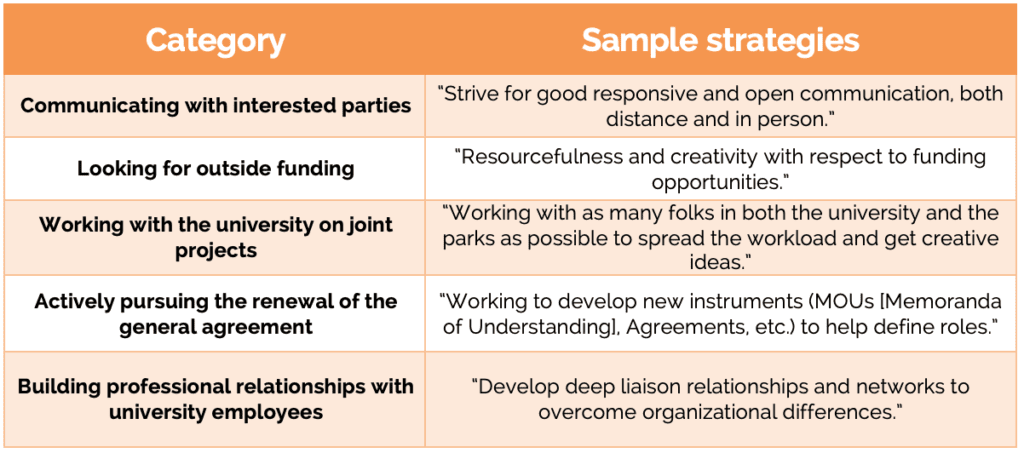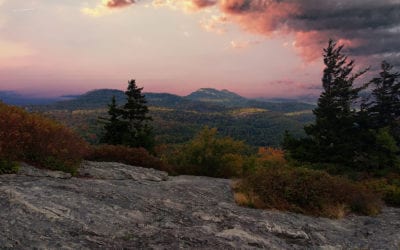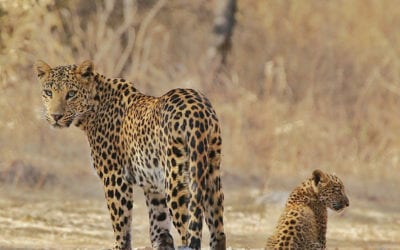Photo Credit: August Miller, UVU Marketing and Communications
Perspectives of US National Park Service Employees on University-National Park Field-Station Partnerships
Communication & Education
August 2019 | Volume 25, Number 2
PEER REVIEWED
Field stations have provided opportunities for place-based learning in protected areas for well over a century (Lohr and Stanford 1996). Today, they continue to allow for the study of current biological problems including climate change and the loss of biodiversity (Baker 2015). Much can be learned from studying organisms in their natural settings that cannot be ascertained in a laboratory (Wilson 1982). In fact, field stations are places where unexpected discoveries are more likely to occur as they attract generations of scientists to a protected area with legacy data sets and the scientific facilities needed to foster discovery (Michener et al. 2009).
Because of their educational and research-oriented missions, field stations are often associated with universities (National Association of Marine Laboratories and Organization of Biological Field Stations 2013) but tend to operate independently (Lohr and Stanford 1996; National Research Council [NRC] 2014). Field stations can expand their capacities for education, research, and outreach through the formation of partnerships (Lohr and Stanford 1996; National Research Council [NRC] 2014). In particular, the NRC (2014) highlighted the benefits of field-station partnerships involving national parks. Furthermore, the Organic Act of 1916 that established the US National Park Service (NPS) specifically mentioned the NPS cooperating with other organizations (Kulhanek et al. 2017). One specific type of field-station partnership involves university-operated field stations located inside US National Park System units (U-NP field stations), described by Stevens and Gilson (2016a). These U-NP field stations are managed by a university or universities and located on national park land. In most cases, the NPS retains ownership of both the land and the buildings associated with the field station (Stevens and Gilson 2016a).
The number of U-NP field stations has nearly quadrupled in the last two decades. Currently, there are U-NP field stations located in 11 US National Park System units, whereas there were only three prior to 2000. U-NP field stations are located in Buffalo National River, Capitol Reef National Park, Channel Islands National Park, Grand Teton National Park, Lassen Volcanic National Park, Mojave National Preserve, Point Reyes National Seashore, Santa Monica Mountains National Recreation Area, Sequoia & Kings Canyon National Parks, Virgin Islands National Park, and Yosemite National Park (Figure 1).
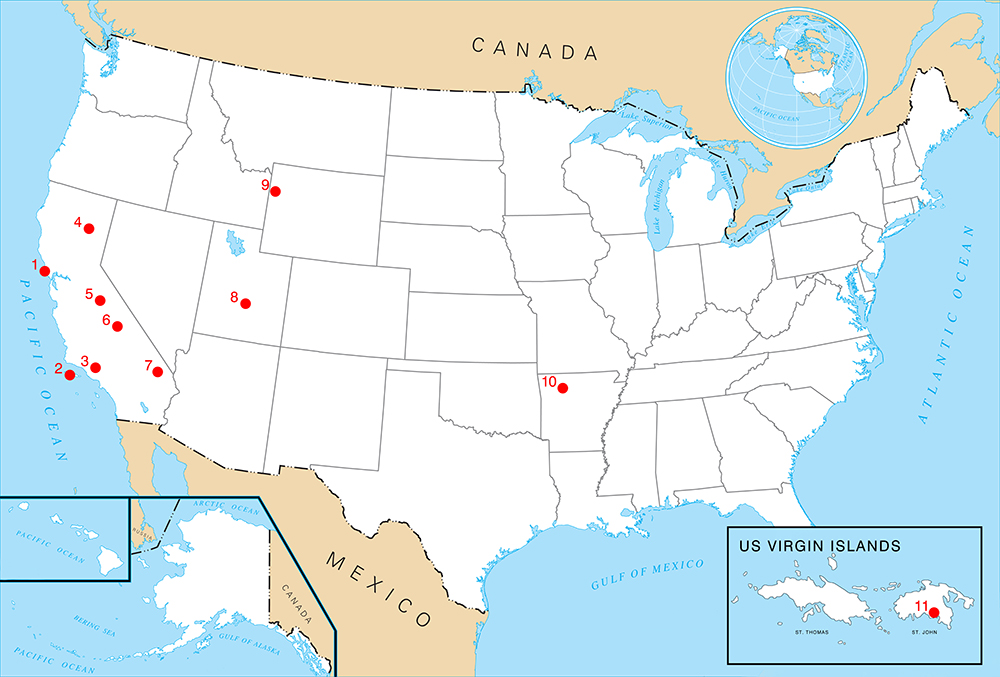
Figure 1 – There are university-operated field stations located inside eleven US National Park System units including: 1) Point Reyes National Seashore, 2) Channel Islands National Park, 3) Santa Monica Mountains National Recreation Area, 4) Lassen Volcanic National Park, 5) Yosemite National Park, 6) Sequoia & Kings Canyon National Parks, 7) Mojave National Preserve, 8) Capitol Reef National Park, 9) Grand Teton National Park, 10) Buffalo National River, and 11) Virgin Islands National Park.
Although the number of U-NP field stations has been increasing, this expansion has only been examined from the perspectives of university employees (Stevens and Gilson 2016a). The purpose of this article is to discuss the opportunities and challenges associated with field-station partnerships and what strategies are used to manage and improve them. It utilizes data collected from NPS employees (from November 2017 to May 2018) who are involved in these partnerships to help understand the nature of field stations in US national parks. Results are then compared to university-employee perspectives previously investigated by Stevens and Gilson (2016a). Functional partnerships can improve the ability of field stations to serve as centers for education and research inside protected areas. Communication emerged as an effective strategy to both maximize opportunities and minimize challenges associated with U-NP field stations.
Opportunities and Effective Strategies
NPS employees shared the greatest opportunities associated with their field-station partnership (Table 1). The most prevalent responses were that field stations offer a venue for undergraduate/graduate education (Figure 2) and provide an excellent location for research. The next most common responses included the prospects for networking with university faculty and possibilities for outreach to local communities (Table 1).

Table 1 – What are the greatest opportunities associated with your university-national park field-station partnership?
It is not surprising that education is seen as an opportunity for NPS employees given their organization’s mission-level focus on education (NPS Interpretation, Education, and Volunteers Program [NPS IEVP] 2014). Similarly, research is a key interest of NPS employees involved with field-station management. Because national parks are often understaffed in terms of research personnel (NRC 2014), NPS employees involved with U-NP field stations recognize the value of collaborating with university faculty and students to accomplish the park’s research agenda as well as the logistical support that field stations offer researchers. Opportunities for education and research were also the top two categories listed by university employees involved with field stations in the prior study by Stevens and Gilson (2016a).

Figure 2 – National Park Service employees (Leah McGinnis and Scott Brown) interacting with students at Capitol Reef Field Station. Credit: Gina Gilson
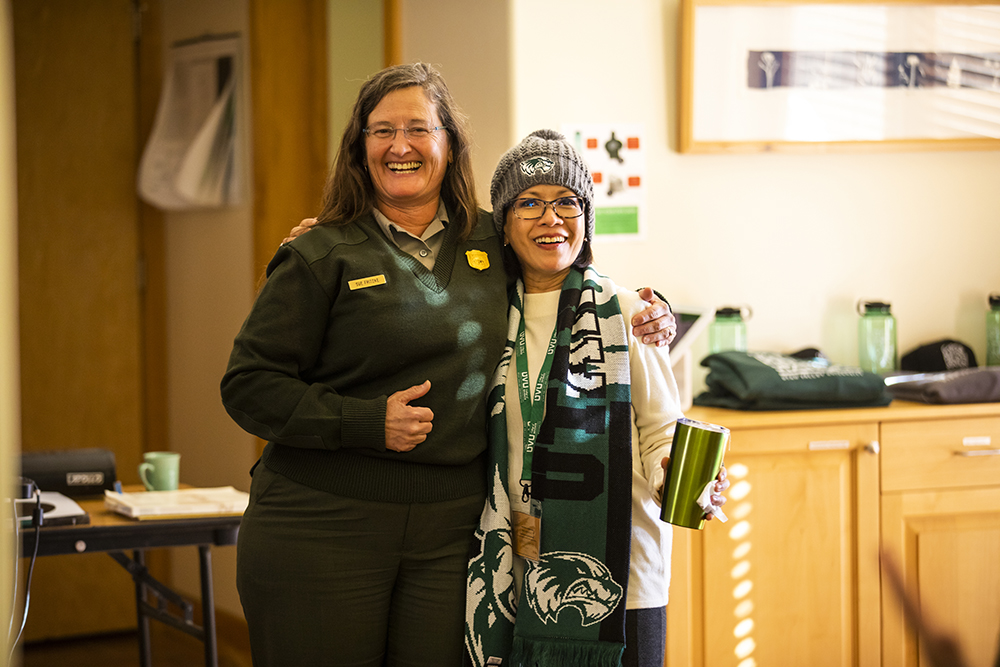
Figure 3 – Superintendent Sue Fritzke (Capitol Reef National Park) and President Astrid Tuminez (Utah Valley University) celebrating the 10th anniversary of Capitol Reef Field Station. Credit: August Miller, UVU Marketing and Communications
The two opportunities not mentioned by NPS employees that were on the list for university employees were that field stations give access to national parks and allow for the sharing of resources. These omissions make sense given that a field station is only one of many ways in which the NPS provides access to a national park. Field-station buildings and surrounding lands are typically owned by the national park and shared with their university through a general or cooperative agreement.
NPS employees were asked how to maximize these potential opportunities. Strategies included communicating effectively and relationship building (Figure 3), facilitating research and permitting, attracting a variety of disciplines and user groups, and supporting programs for the public and local communities (Table 2). NPS field-station liaisons need to communicate both with their park superintendents and with university field-station directors. NPS employees were much more likely to mention communication as an effective strategy than were university employees (Stevens and Gilson 2016a). Perhaps the culture of the NPS places a greater emphasis on communication than does academia. Although fewer than half of NPS employees responded positively to the statement that their managers promote communication (US Office of Personnel Management [US OPM] 2015), Massy, Wilger, and Colbeck (1994) reported especially fragmented communication among university faculty as well.
NPS employees were unlikely to mention maintaining and improving facilities as a strategy to maximize the opportunities of their field-station partnership. The fact that maintaining and improving facilities was unlikely to be mentioned by NPS employees could be due to the fact that the majority of field-station agreements require the university to provide maintenance for the park-owned field station buildings that they use. Additionally, helping groups with scheduling and garnering financial support were two categories highlighted by university employees (Stevens and Gilson 2016a) but not mentioned by NPS employees. These activities may tend to fall more under the purview of universities involved in these partnerships.
Challenges and Mitigation Efforts
The greatest challenges of these types of partnerships listed by NPS employees were varied and included providing adequate facilities and space, obtaining necessary funding, being under the jurisdiction of two different organizations instead of just one, finding the time to be as involved as they would like to be, accepting the limitations associated with a particular type of university, dealing with policies and timelines of the federal government, and maintaining effective communication (Table 3).
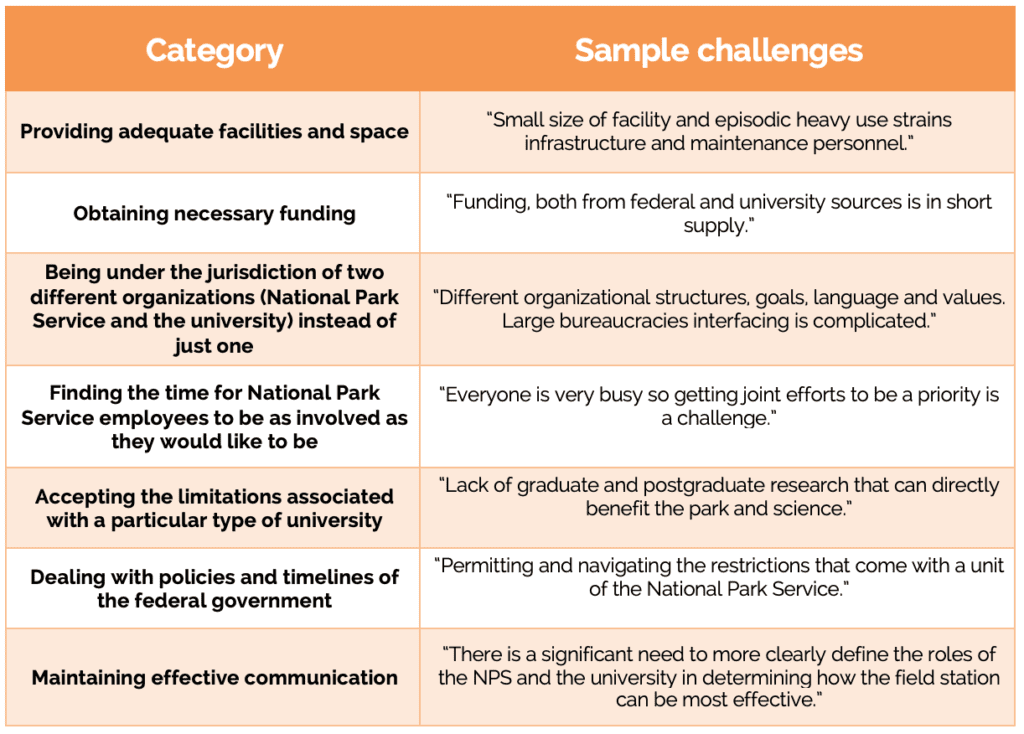
Table 3 – What are the greatest challenges associated with your university-national park field-station partnership?
NPS employees were most likely to highlight the challenge of providing adequate facilities and space at their field stations. Perhaps they view their field station in the context of parkwide inadequacies in facilities and the human resources necessary to maintain them. For instance, only 29% of NPS employees surveyed by the US OPM (US OPM 2015) responded positively that they have sufficient resources to get their job done. This perception of lack of resources in the NPS could explain why so few NPS employees indicated maintaining and improving facilities as a strategy to maximize the opportunities of their field-station partnership. Compared to NPS employees, university employees were much less likely to highlight the challenge of providing adequate facilities (Stevens and Gilson 2016a) and may be more willing to accept the limitations of their field station’s facilities because of its off-campus location inside a national park. NPS and university employees were similarly concerned about obtaining necessary funding – an ever-present challenge for many field stations (Hodder 2009) – and being under the jurisdiction of two different organizations (the NPS and the university) instead of just one. One NPS employee noted that “large bureaucracies interfacing is complicated” (Table 3).
NPS employees brought up two unique categories of field-station management challenges that were not mentioned by university employees: finding the time to be as involved as they would like to be in their field-station partnership and accepting the limitations associated with their particular type of university partner. Regarding finding the time to be involved, it is possible that NPS staffing is too thin to easily devote the time required to foster their field-station partnership. This supposition is supported by a survey conducted by the US OPM in which they reported that 91% of NPS employees responded positively that the work they do is important, but that only 38% indicated that their workload was reasonable (US OPM 2015). This challenge could be mitigated if park superintendents were able to designate one NPS employee as the field-station liaison and provide the time and resources necessary to accomplish this task. The fact that the majority of U-NP field-station liaisons were chiefs of their respective divisions is evidence that NPS superintendents are placing a high degree of importance on their field-station partnerships. In reality, however, this additional assignment generally doesn’t come with additional time or resources and could contribute to NPS employees feeling overworked (US OPM 2015).
With respect to accepting the limitations of their associated university, NPS employees indicated wanting to be partnered with a university with a greater focus on research or with a greater diversity of students. Accessing field-station locations was a challenge category listed by university employees (Stevens and Gilson 2016a), but not shared by NPS employees. Since U-NP field stations are located in national parks, it makes sense that they are more accessible to NPS employees. University employees typically work on campuses that are long distances away from their field stations, which can be in remote parts of national parks such as on islands or along unpaved roads.
The top challenge mentioned by university employees, dealing with policies and timelines of the federal government (Stevens and Gilson 2016a), was much less likely to be shared by NPS employees. Perhaps NPS employees are less concerned with this challenge because of their experience negotiating the complexities of the federal government. One federal policy/timeline issue that is particularly vexing for university employees is the NPS’s practice of managing field stations under a five-year agreement. The short-term nature of these agreements makes it difficult for universities to commit resources to their field station and to secure support from university donors. One U-NP field station, the University of Wyoming-National Park Service Research Station in Grand Teton National Park has negotiated a longer (20-year) agreement. Of note, the Organic Act of 1916 that established the NPS allows for longer partnerships, up to 30 years in duration (NPS Organic Act 1916).
When asked about the most effective strategies to minimize these challenges, responses converged on communicating with interested parties. Looking for outside funding was mentioned by a few of the respondents. Fewer still shared three other strategies, including working with the university on joint projects, actively pursuing the renewal of the general agreement (that describes the terms of their field-station partnership), and building professional relationships with university employees (Table 4).
Communicating with interested parties was the top way to manage challenges associated with U-NP field stations championed by NPS employees. The success of communication as a strategy to minimize challenges is corroborated by the fact that maintaining effective communication was listed as a challenge by only a few NPS employees in Table 3. Communication was also shared by university employees as way to minimize challenges, but half of them also listed maintaining effective communication as a potential challenge (Stevens and Gilson 2016a), perhaps for reasons discussed in Massy, Wilger, and Colbeck (1994). The other four categories (Table 4) were less likely to be mentioned by NPS employees than by university employees. Of note, NPS employees were less likely than university employees to consider renewing the five-year agreement as a challenge. It appears that the onus for pursuing such an agreement falls primarily on university employees. Perhaps NPS field-station liaisons can take a more active role in renewing their agreements with their partnering university, and also encourage their park to offer its associated university a longer-term agreement of 10, 20, or even 30 years.
Field Stations: Fulfilling Missions and Realizing Benefits
NPS employees shared four main ways in which their field station helped the NPS fulfill its mission. The vast majority of respondents said that their field station supported research that informs park management. A smaller majority mentioned offering educational opportunities to a variety of students. Others indicated that their field station promoted the park and the mission of the NPS and highlighted that their field station provided a facility and staff that can be utilized by the park (Table 5). With regard to how U-NP field stations benefited their associated university and helped fulfill the university’s mission, NPS employees mentioned presenting opportunities for curriculum enrichment, offering research opportunities, and providing access and facilities off campus in a unique environment (Table 6).
The fact that supporting research that informs park management topped the list of ways in which U-NP field stations benefit the NPS is not surprising given the NPS’s increasing desire to foster research within park boundaries (Kaiser 2000; Parsons 2004). In fact, with increasing environmental changes brought about by humans, national parks become increasingly valuable places for research assessing the effects of climate change and land management practices in comparatively intact ecosystems (Turner et al. 2017). The next most commonly mentioned benefit of field stations, offering educational opportunities to a variety of students, was also expected given the emphasis the NPS places on education and interpretation (NPS IEVP 2014). Furthermore, connecting students with natural ecosystems is an excellent way to foster science education and get students thinking about careers in both the natural and social sciences (Wilson 2017). Many field stations help educate their visitors about the mission of the NPS, and this benefit was noted by multiple NPS employees. In particular, one NPS employee highlighted the ability of a U-NP field station to bring in people who wouldn’t typically visit a national park and connect them with the NPS’s mission of conservation (Table 5).
With regard to how U-NP field stations benefited their associated university and helped fulfill the university’s mission, NPS employees listed connecting “undergraduate students to [the national park],” serving “as an anchor for field research,” and offering “an excellent change in venue for off-campus learning experiences” (Table 6). Similar ideas were also shared by university employees associated with U-NP field stations (Stevens and Gilson 2016a). The fact that there is such a high degree of alignment between how NPS employees and university employees view the benefits of U-NP fields stations could reflect the effective communication that occurs between each of these groups.
Improved management practices can also stem from opportunities for networking and learning from each other in person such as those made available at National Science Foundation–funded conferences (Stevens and Gilson 2016b), at George Wright Society Biennial Conferences (Wakelee et al. 2015), and at the Organization of Biological Field Stations annual meetings (Kelly and Stevens 2017; Brown et al. 2018).

Table 5 – How does your field station benefit the National Park System unit in which it is located or help the NPS fulfill its mission?
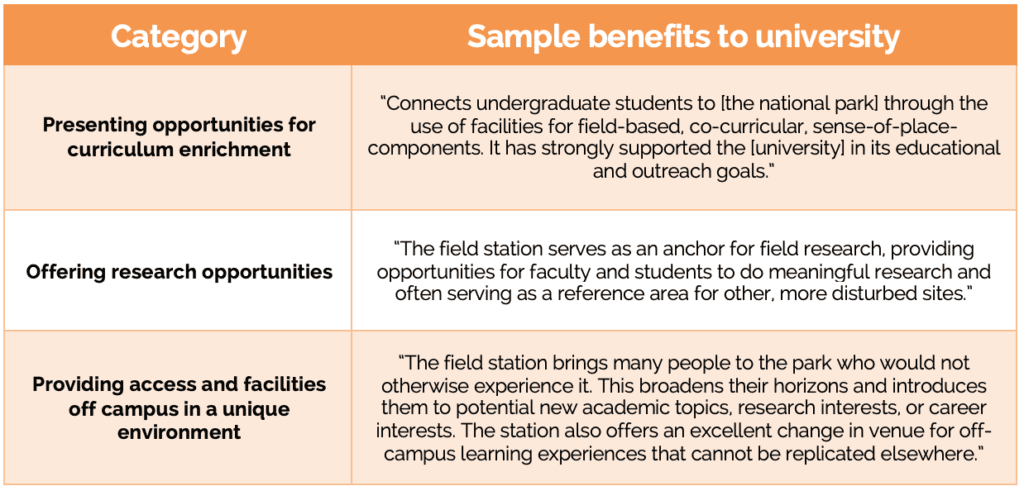
Table 6 – How does your field station benefit your associated university or help it fulfill its mission?
Conclusions
Field stations inside protected areas have a rich history and ongoing relevance (Lohr and Stanford 1996; Baker 2015). This analysis of the educational and research-oriented benefits of U-NP field stations from the perspective of NPS employees, and the importance of communication in such partnerships, can be used to improve the management of these particular facilities. Additionally, because interactions between the NPS and a university can be complex, the study of these interactions can provide insights for other types of protected-area management partnerships including those with local, state, or other federal agencies in the United States as well as internationally. The fact that the number of U-NP field stations continues to grow is evidence that the benefits of these partnerships outweigh the drawbacks for both the NPS and its associated universities.
Interestingly, the increase in the number of U-NP field stations appears to be driven by relationships between universities and individual national parks rather than by regional or Washington, D.C.–based NPS offices. Individual NPS managers may be seeking partnerships with universities as an alternative way to accomplish the mission of the NPS under conditions where many NPS employees perceive a lack of resources to get their jobs done (US OPM 2015). Perhaps national recognition of the U-NP field station phenomenon could lead to more consistent agreements between individual NPS units and their associated universities.
In sum, U-NP field stations fit well within the mission of the NPS. They are successfully being used by park managers to expand their research capacity by attracting university faculty and student researchers. The undergraduate students that faculty bring are younger and more diverse than are typical national park visitors (Gramann 2003). Working with these students at field stations is an efficient form of outreach for the NPS because the populations of interest come to the park instead of the other way around (McCown et al. 2011). While in the park, students can experience in situ opportunities for education, research, and career exploration (Gladfelter 2002; Michener et al. 2009; Fleischner et al. 2017) that “cannot be replicated elsewhere” (Table 6).
Acknowledgments
Thank you to the NPS employees who participated in this survey. The conference participants at the University-National Park Field-Station Conference held at Capitol Reef Field Station in July 2016 helped generate the idea for this study. Leah McGinnis, superintendent at Saguaro National Park and formerly at Capitol Reef National Park, provided valuable feedback on the manuscript. Funding was provided by the National Science Foundation Division of Biological Infrastructure (grant no. 152246) through the Improvements in Facilities, Communications, and Equipment at Biological Field Stations and Marine Laboratories (FSML) program.
MICHAEL T. STEVENS is a professor of biology at Utah Valley University and the director of Capitol Reef Field Station located in Capitol Reef National Park; email: michael.stevens@uvu.edu.
References
References
Baker, B. 2015. The way forward for biological field stations. BioScience 65(2): 123–129.
Brown, J., A. Kelly, A. Miller-Rushing, M. T. Stevens, and H. Webber. 2018. Field Stations on Public Lands. A
workshop and concurrent session presented at the Organization of Biological Field Stations Annual Meeting, Winter Harbor, ME, September 19 and 23.
Fleischner, T. L., R. E. Espinoza, G. A. Gerrish, H. W. Greene, R. W. Kimmerer, E. A. Lacey, S. Pace, J. K.
Parrish, H. M. Swain, S. C. Trombulak, et al. 2017. Teaching biology in the field: Importance, challenges, and solutions. BioScience 67(6): 58–67.
Gladfelter, E. H. 2002. Agassiz’s Legacy: Scientists’ Reflections on the Value of a Field Experience. Oxford, England: Oxford University Press.
Gramann, J. H. 2003. Trends in Demographics and Information Technology Affecting Visitor Center Use: Focus Group Report. Washington, DC: National Park Service Social Science Program.
Hodder, J. 2009. What are undergraduates doing at biological field stations and marine laboratories? BioScience 59(8): 666–672.
Kaiser, J. 2000. Bringing science to the national parks. Science 288(5463): 34-37.
Kelly, A., and M. T. Stevens. 2017. Field stations on federal lands. A concurrent session presented at the Organization of Biological Field Stations Annual Meeting, Lake Itasca, MN, September 23.
Kulhanek, K. A., L. C. Ponisio, A. C. Schneider, and R. E. Walsh. 2017. Strategic conversation: Mission and relevance of national parks. In Science, Conservation, and National Parks, ed. S. R. Beissinger, D. D. Ackerly, H. Doremus, and G. E. Machlis (pp. 64–71). Chicago: University of Chicago Press.
Lohr, S., and J. Stanford. 1996. A new horizon for biological field stations and marine laboratories. Trends in Ecology & Evolution 11(5): 228.
Massy, W. F., A. K. Wilger, and C. L. Colbeck. 1994. Overcoming “hollowed” collegiality. Change 26(4): 10–20.
McCown, R. S., J. L. Tuxill, D. N. Laven, N. J. Mitchell, R. E. Manning, and J. L. Jewiss. 2011. Beyond Outreach Handbook: A Guide to Designing Effective Programs to Engage Diverse Communities. Woodstock, VT: National Park Service Conservation Study Institute.
Michener, W. K., K. L. Bildstein, A. McKee, R. R. Parmenter, W. W. Hargrove, D. McClearn, and M. Stromberg. 2009. Biological field stations: Research legacies and sites for serendipity. BioScience 59(4): 300–310.
National Association of Marine Laboratories and Organization of Biological Field Stations. 2013. Place-based research site strategic planning survey: Results summary. Retrieved August 28, 2018, from http://www.obfs.org/fsml-future.
National Park Service Interpretation, Education, and Volunteers Program. 2014. Achieving relevance in our second century. Retrieved August 28, 2018, from www.nps.gov.
National Park Service Organic Act. 1916. 16 USC. 1-4 (39 Stat. 535) and Amendments thereto.
National Research Council. 2014. Enhancing the Value and Sustainability of Field Stations and Marine Laboratories in the 21st Century. Washington, DC: The National Academies Press.
Parsons, D. J. 2004. Supporting basic ecological research in U.S. national parks: Challenges and opportunities. Ecological Applications 14(1): 5–13.
Stevens, M. T., and G. G. Gilson. 2016a. An exploration of field-station partnerships: University-operated field stations located in US national parks. BioScience 66(8): 693–701.
———. 2016b. University-national park field station partnership conference. A conference presented at Capitol Reef Field Station, UT, July 20–23.
Turner, M. G., D. C. Donato, W. D. Hansen, B. J. Harvey, W. H. Romme, and L. Westerling. 2017. Climate change and novel disturbance regimes in national park landscapes. In Science, Conservation, and National Parks, ed. S. R. Beissinger, D. D. Ackerly, H. Doremus, and G. E. Machlis (pp. 77–101). Chicago: University of Chicago Press.
US Office of Personnel Management (OPM). 2015. Federal employee viewpoint survey results for: National Park Service. Washington, DC: National Park Service.
Wakelee, D., T. Arsuffi, B. Fenwick, and M. T. Stevens. 2015. Field stations in national parks: Opportunities and challenges. A concurrent session presented at the George Wright Society Biennial Conference on Parks, Protected Areas, and Cultural Sites, Oakland, CA, March 31.
Wilson, E. O. 1982. The importance of biological field stations. BioScience 32(5): 320.
Wilson, E. O. 2017. Parks, biodiversity, and education: An essay and discussion. In Science, Conservation, and National Parks, ed. S. R. Beissinger, D. D. Ackerly, H. Doremus, and G. E. Machlis (pp. 7–16). Chicago: University of Chicago Press.
Read Next
WILD11 India: Nature-Based Solutions for Life, Livelihoods, and Love
We are pleased to tell you that the 11th World Wilderness Congress (WWC WILD11) will convene in Jaipur, India, in March 2020.
The Historical Meaning of “Outstanding Opportunities for Solitude or a Primitive and Unconfined Type of Recreation” in the Wilderness Act of 1964
The federal land management agencies responsible for wilderness stewardship in the United States play a critical role in fulfilling the Wilderness Act’s mandate to preserve wilderness character.
Jhalana: The Abode of the Urban Leopards
Imagine living in a crowded city of 3.1 million people and learning that amidst this human world, the huge buildings, the maddening crowd, and the deafening sounds lies a small, happy, and peaceful refuge where wild leopards rule.


